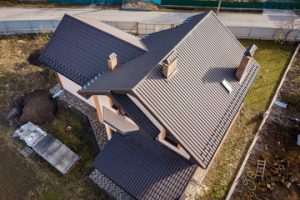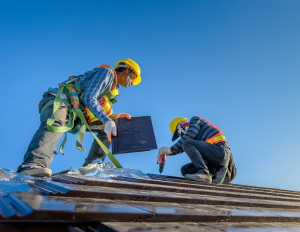Whether you are dealing with insurance or simply want to ensure the work is done well, find a contractor who offers a warranty. This protects you if the contractor makes mistakes on the job and helps you avoid additional repair costs.
Localized damage is ideal for repair – replacing a few missing shingles, for example. However, if your roof is aging and you experience frequent weather-related damage, replacement may be the better option. Get a Free Quote Today by reading the article below.

When a leak develops in your roof, it’s essential to call for immediate repair. Even small leaks can create biological growth and damage the structure of your home, resulting in significant and expensive damage. Here are some signs you have a leak:
Water Staining on Ceiling Walls
If you notice dark spots on your ceiling walls, this indicates continuous flow of water through those areas. This may lead to damage to the internal drywall and insulation. Leaks in the roof can also cause damage to the wooden frame and rafters.
Leaks in the roof can result from many causes. The most common include people, issues with seams, neglect, rooftop equipment and weather. These problems can be avoided by conducting routine maintenance and taking prompt action in the event of a leak.
Most leaks are caused by deterioration of the flashing or sealant. This can be due to age or improper installation. It is crucial for homeowners to have their roofs professionally installed to ensure they are getting the best quality material.
Another common reason for a leak is the failure of flashing around a chimney, skylight or other penetrations on the roof. The flashing is a strip of metal that sits at the joints in the roof. This is designed to prevent water from seeping through the roof at those points.
A third common reason for a roof leak is damage or aging of the sheathing and trusses. This can occur from severe storms, impact or improper installation. It’s important to inspect your roof after major storms to catch any damage and address it promptly.
Some of the most common roof leak repair techniques are patching, reinforcing and replacing sections of the roofing materials. These techniques are often used in conjunction with other roof maintenance activities, such as attic ventilation and a vapor barrier.
A vapor barrier helps regulate moisture levels, preventing condensation and promoting a healthy roof. Other roof maintenance includes cleaning debris from gutters and regularly examining the flashing, insulation and underlayment for damage and deterioration. Homeowners can make temporary fixes using roofing cement or caulking to seal cracks and gaps.
Sagging
The structural integrity of your roof is vital to the safety of your home. If you see any signs of sagging, it’s critical to take action promptly. Sagging isn’t just a cosmetic issue; it’s a warning sign that your roof is about to collapse, which can cause serious damage. There are two main causes of sagging: water damage and structural weakness. The best way to address either of these problems is to hire an experienced roofing contractor to perform a thorough inspection and recommend the right course of action.
Visual indicators of a sagging roof include noticeable dips or depressions along the roofline, especially near the ridge. This unevenness signals underlying issues that impact the structure of your roof and the rest of your home. If left unchecked, sagging can lead to leaks and mold growth that affect walls and ceilings throughout your home.
One of the most common causes of sagging is moisture penetration, which weakens wooden beams and joists that support your roof. This can happen when water seeps into the shingles or the underside of your roof, or when gutters become blocked and cause water to collect beneath the eaves. Left unchecked, this moisture can eventually rot the joists and beams, which may weaken or even collapse your roof.
Another common reason for sagging is wood-eating pests, such as termites, carpenter ants, and wood-boring beetles. These creatures burrow into the wood of joists and trusses, which can weaken the structure and create gaps that allow water to seep into your home. Regular pest inspections and prompt treatment can prevent these infestations from damaging your roof.
Over time, all roofing materials lose their strength and durability, causing them to deteriorate. If your roof is 15-20 years old and showing signs of sagging, it’s likely time to replace it. Luckily, replacing your roof early can help reduce the likelihood of future sagging or water damage. To protect your investment, be sure to hire an experienced roofer to inspect your sagging roof and recommend the correct repairs. They’ll also identify underlying issues that can prevent your roof from sagging in the future and recommend other preventive measures, like repairing gutters and addressing drainage problems.
Mold
Mold spores can quickly grow and spread throughout building materials, damaging them and causing health problems. In addition to the damage to materials, mold spores can also trigger asthma and other respiratory issues. Mold growth often accompanies water damage, so it’s important to check for any signs of moisture in the home and to address those issues promptly.
Look for discoloration on walls or ceilings. This may be a sign of water leaks or of a roof that is in need of repair. Also, look for any signs of mold in the attic, including discoloration of insulation and wood joists or rafters. If you spot any of these signs, contact a professional to inspect the roof.
You can prevent mold from growing in the first place by keeping water and humidity levels low in indoor areas. For example, keep the air ducts clean and vacuum the floors frequently to remove accumulated dirt and debris that can encourage mold growth. Also, regularly clean and maintain gutters to ensure they are free of blockages and are properly directing water away from the house.
When choosing a company to handle your roof repair and mold remediation, choose one with extensive experience. A company with decades of experience will have dealt with many different situations and will be able to identify the root causes quickly and efficiently. In addition, look for customer reviews and ratings on various platforms to get a feel for the company’s reputation and quality of service.
While some people may confuse mold with mildew, it’s important to note that these are two different types of fungus. Mildew is more common in homes and doesn’t cause as much damage to roofing materials, but it can still wreak havoc on the structure of buildings. It’s best to avoid using bleach or vinegar to try to kill mildew, as this can actually lead to more damage and make the fungus resistant to treatment. Instead, consider a product that is specifically designed to eliminate mold. These products usually contain a fungicide and can be sprayed directly onto the affected area to kill the mold and prevent it from returning.
Age
Over time, a roof naturally wears down and requires restoration. This natural aging process affects all roofing materials. Having an understanding of the age of your roof can help you determine how frequently it will need repair and when a full replacement might be in order. Knowing the age of your roof can also help you plan repairs and budget for future restoration needs.
In general, roofs are expected to last about 20 years before a complete replacement is needed. It is important to keep in mind that this lifespan varies depending on roof type, sun exposure, and other environmental factors. However, most roofs will begin showing signs of deterioration as they reach this point.
As a general rule, it is important to check your roof regularly and address any issues that arise as soon as possible. This can save you from costly damage and even structural problems in the long run. The key to extending the life of your roof is proactive maintenance, which includes regular inspections, prompt repair of cracks and leaks, proper pigeon proofing, and tree trimming.
A few common indicators that your roof may be nearing the end of its lifespan include a sagging roof, visible granule loss in gutters and on the ground, and shingle or tile chips or flakes. Leaks and water stains can also indicate that your roof is aging and could require repairs or a full replacement in the near future.
Another sign that your roof might be aging is one side of the roof being in direct sunlight more than the other side. This can cause the shingles to degrade more quickly on the shady side, resulting in discolouration and surface weakness. This can also lead to increased porosity, which can encourage the growth of mould and moss on your roof.
Many of these warning signs can be easily spotted by an experienced professional. Roofers are trained to spot signs that might be missed during a visual inspection, such as a small amount of granule loss or a few areas of cracking. A skilled roofer can also look for things like compromised flashing and seals around chimneys, vents, and skylights that can allow water into your home.
